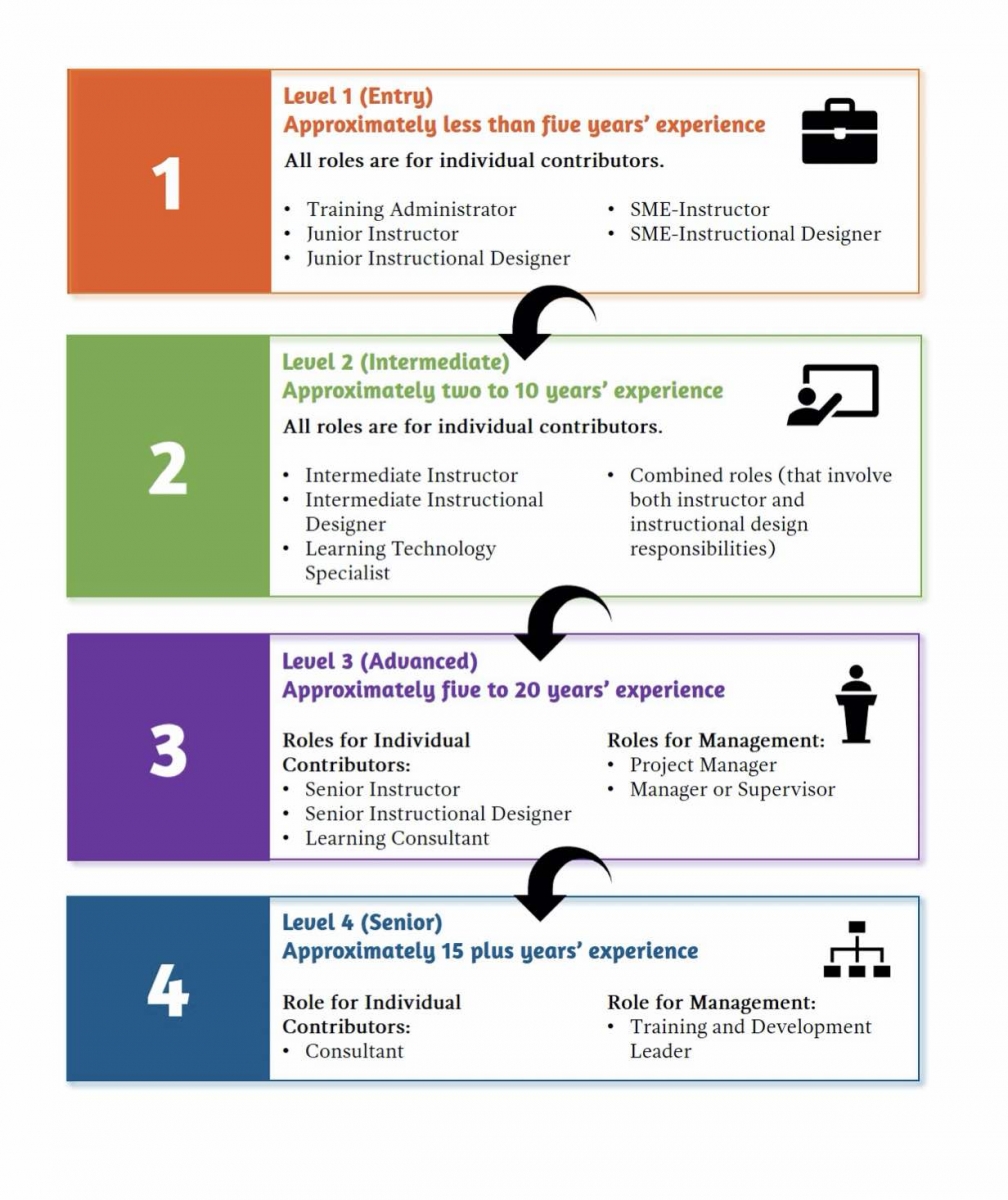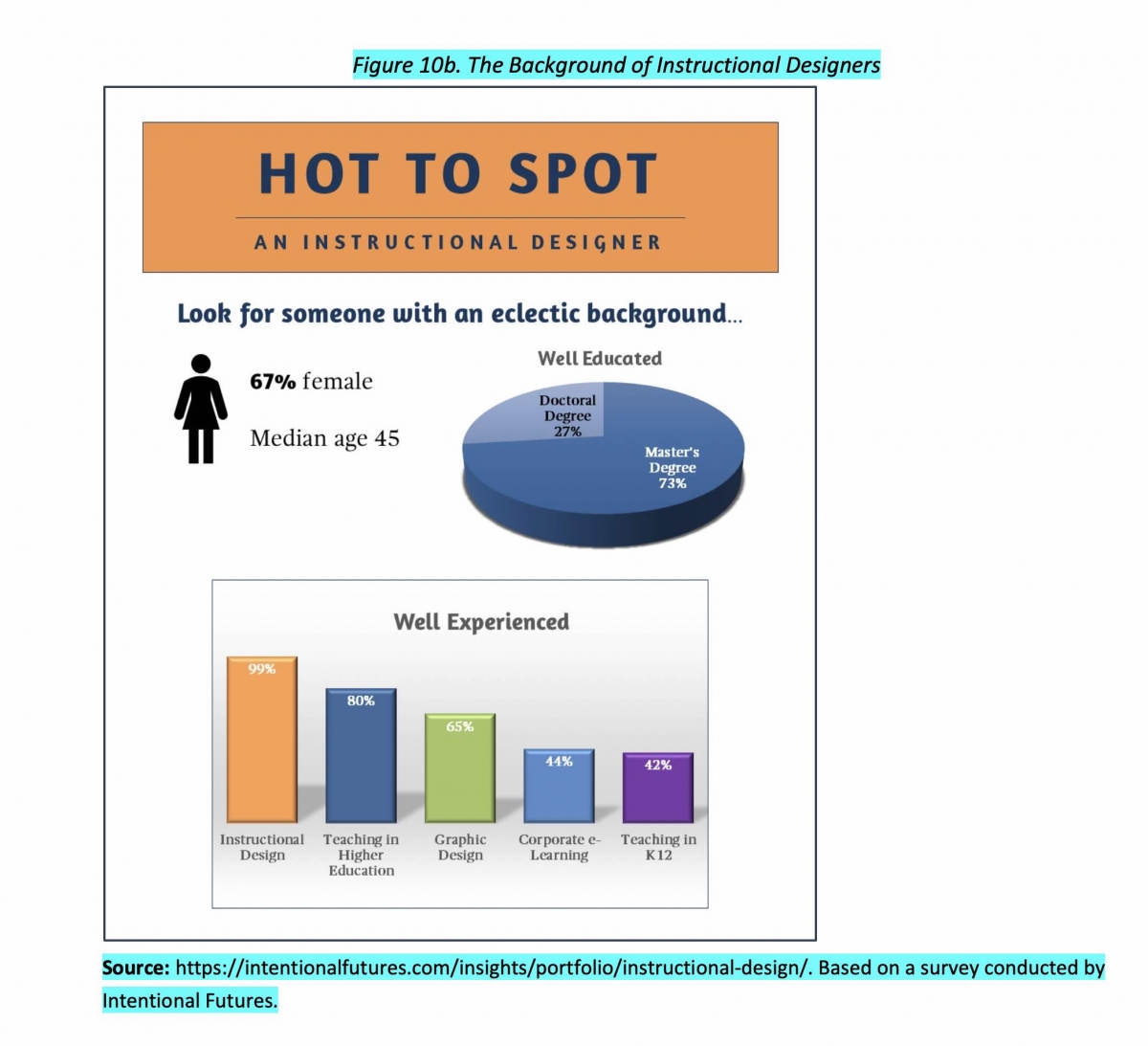Two general career paths exist in Training and Development:
- Individual contributor path intended for people who have great expertise in the field but are not interested in serving in a management role.
- Management path intended for people who seek management roles.
Although they involve different jobs, both career paths allow for growth over time, an increasing span of influence, and increasingly complex job assignments.
A career path in the field typically involves four levels.
Figure 10a. Summary of Career Paths

Level 1 is the entry level, which is intended for people who are just starting in the field. Several entry-level jobs exist, including training administrator, junior or subject matter expert (SME) instructor, and junior or SME instructional designer. The typical number of years of experience required for an entry-level role is zero to five years.
Level 2 in the career path is the intermediate level. Level 2 professionals might have been promoted from junior to intermediate instructor or junior to intermediate instructional designer positions. Level 2 also comprises learning technology specialists and combined roles (that involve both instructor and instructional design responsibilities). The typical number of years of experience required for intermediate roles is two to 10 years.
All of the roles in the first two levels are primarily intended for individual contributors.
Level 3 in the career path involves advanced roles, which include roles for individual contributors and managers. Individual contributor roles include senior instructor, senior instructional designer, and learning consultant. Management roles include project manager and manager or supervisor. The typical number of years of experience required for advanced roles is five to 20 years.
Level 4 in the career path involves senior roles. The individual contributor role at this level is a consultant. The management role at this level is Training and Development leader. The typical number of years of experience required for senior roles is 15 or more years.
Although this discussion and Figure 10a suggest that career paths follow a straight and forward-moving path, the reality is that most careers don’t. Instead, they tend to proceed through a changing course that does not necessarily involve a smooth progression from Level 1 to Level 4. Training and Development professionals move often among the roles of instructor, instructional designer, learning consultant, and learning technology specialist during their careers. For example, an instructional designer might move into a learning technology specialist role, then move back into an instructional designer role later on, even though some might consider this to be a step backward.
Sometimes professionals stay in the same role at the same level but move to different parts of an organization or to an entirely different organization to accept new challenges. This provides them with a broader depth of experience. For example, a technical trainer might move to a sales training group to develop a broader base of expertise in different types of training.
Sometimes professionals at the third and fourth levels of the career ladder move back and forth between individual contributor and management roles. In some instances, the individual has particular expertise that’s needed in a role. In other instances, the individual moves to a new role because he or she wants the change of pace offered by that role. For example, a training manager might move into a learning consultant role, as both are Level 3 roles that require management of customer relationships. He or she might choose to do so to take a break from managing staff and move back into an individual contributor role.
Some people work full-time throughout their careers; others spend some or all of their careers working part-time. Such a decision is a personal one. What is important is that Training and Development offers options for full- and part-time work. For those who prefer to work part-time, some organizations offer part-time and job-sharing positions. Many also offer flexible working hours. Service providers also offer work-related flexibility, including part-time options and flexible working hours, as well as the option not to work for periods of time.
The two figures below (and also downloadable at the end of this article) provide more information on the career paths and background of instructional designers. Figure 10b provides a summary of the education, employment experience, and demographics of instructional designers in the U.S, where there are an estimated 13,000 instructional designers. Figure 10c summarizes the four key job functions of instructional designers.


Margaret Driscoll and Saul Carliner will present a track of breakout sessions (Training Essentials, Learning Essentials, Business Essentials, and Technology Essentials) during the Training 2020 Conference & Expo February 24-26 in Orlando, FL. To register, visit: www.trainingconference.com.
Excerpt from Chapter 10: Your Future in the Field from “An Overview of Training and Development: Why Training Matters” by Saul Carliner and Margaret Driscoll (Lakewood Media, 2019). For more information, click here.
Margaret Driscoll and Saul Carliner are co-authors of “An Overview of Training and Development” and “Advanced Web-Based Training Strategies: Unlocking Instructionally Sound Online Learning,” and internationally recognized as authors, keynote speakers, and experts in training, performance improvement, and related work. Theirs is an international, industry-academe partnership: Driscoll is a training executive who delivers outstanding results for Fortune 500 clients; Carliner is a professor of Educational Technology at Concordia University in Montreal and director of Research at Lakewood Media Group.




